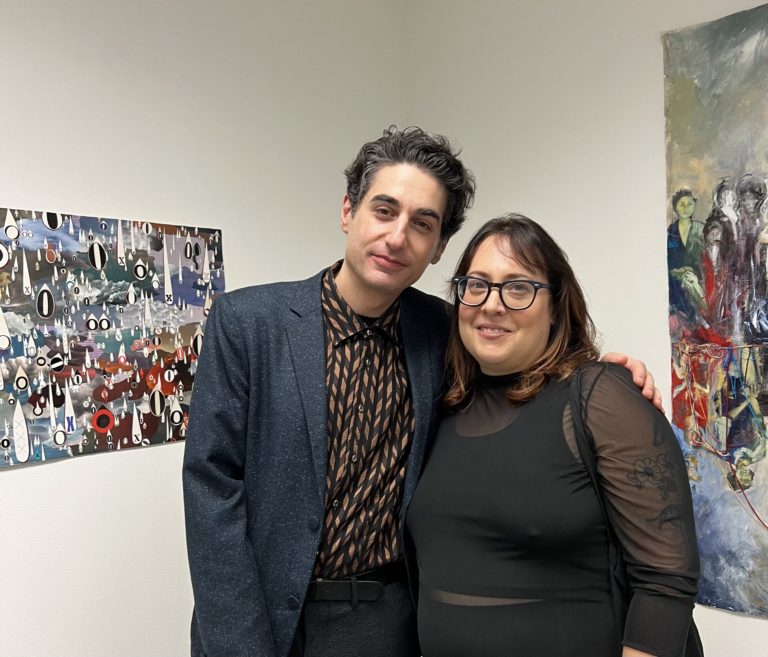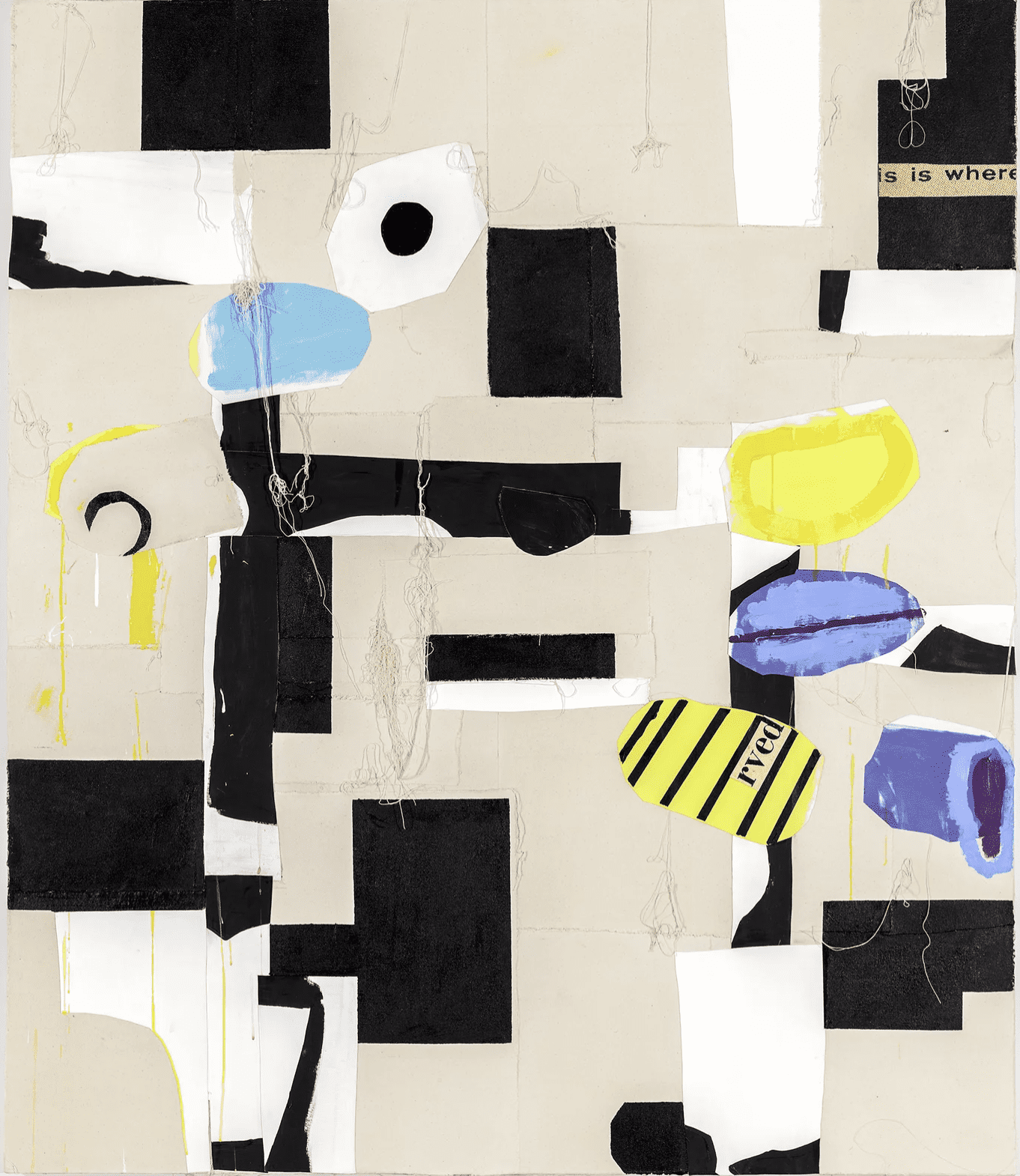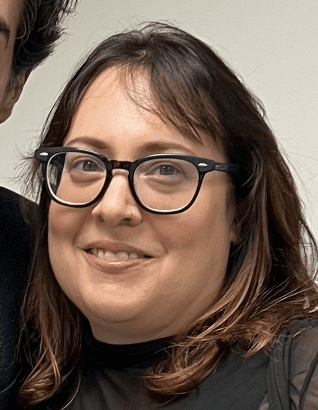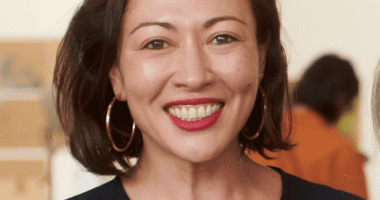The Artsy Asks Series
Experts answer the most important questions for galleries today.
Who
Nicole Restaino, Lead Project Manager for Fair Partnerships, manages the execution of Artsy’s global fair, association, and gallery weekend initiatives. She was previously the Manager for Programming at the International Center of Photography and has more than a decade of experience in arts and culture partnership strategy and program administration. Nicole is passionate about expanding audiences for art and supporting galleries and artists.

Artsy’s Lead Project Manager for Fair Partnerships, Nicole Restaino with artist Marc Alain at ChaShaMa Arts.
In the dynamic world of art fairs and the ever-evolving art market, understanding galleries’ strategies and industry trends can be the key to success. Today, many galleries are crafting online fair booths that showcase their artists and align with a comprehensive brand and business strategy. And when it comes to physical art fair booths, galleries are integrating digital marketing, social media, and in-person events—and leveraging Artsy’s tools to create an engaging experience for collectors.
Below, Nicole Restaino, Artsy’s Lead Project Manager for Fair Partnerships, offers insights on some of the most common issues that galleries may encounter as they participate in art fairs.
What are some of the most successful or creative ways you’ve seen galleries approach their online fair booths?
The most successful booths are those that are not only well curated but also planned with a holistic brand and business strategy. In the art fair strategy sessions that I run with Artsy exhibitors, I recommend that galleries start their planning with our 2023 Guide to Art Fairs and our Gallery’s Guide to Digital Marketing. Regardless of your gallery’s program, these tools prompt you to consider how your digital channels are speaking to one another and how marketing is interfacing with in-gallery programming and other physical events.
Consider a well-established gallery that might be showing at The Armory Show, Frieze London, and Art Basel in Miami Beach in the second half of the year. That gallery may be thinking about how best to integrate its Instagram, Artsy, and programming into its fair strategy. These galleries typically plan their fair inventory for the year and tie their marketing to these events. To align their social strategy, they should showcase their artists that will be showing at each fair, leverage tagging, cross-marketing with the fair organizer, and use data-driven insights.
Instagram content can feature artist interviews, studio tours, and booth tours during the fair, with artists sharing this content for wider exposure. Artists should be consistently tagged, and stories should direct viewers from Instagram to the Artsy artist page, encouraging them to follow the artist there. The videos you post online can be repurposed for the online fair booth you upload to Artsy, focusing on storytelling to connect with collectors.
You may choose to plan an exclusive dinner with artists and top collectors in the city where the fair takes place. Repurpose content from this event for social marketing, and provide attendees with QR code-equipped takeaway items (gift bags or calling cards) directing them to Instagram and the Artsy booth.
In conclusion, while the goal of a fair is to sell works and meet new collectors, I encourage gallery partners to also leverage these moments to grow their artist and gallery follower count on Artsy, increase their artist discoverability on Instagram, and ideally anchor all of these channels around cohesive goals. Storytell, use your Artsy viewing rooms, and add video to CMS to really leverage the interconnectivity of these marketing channels. Planning, preparation, and creativity are the key to a successful fair booth
Have you seen any changes in the past year regarding the types of artworks and artists that galleries are presenting at art fairs?
Aesthetic and stylistic trends become evident during major art weeks such as Frieze, Armory, and Basel. These events offer a wealth of artwork, allowing for easy trend-spotting, with emerging galleries alongside global market leaders, creating a unique opportunity to identify themes.
During New York Art Week in May and Armory Week this past September, I observed a trend towards art historical references, including nods to pre-Renaissance styles, pre-perspective painting, illuminated manuscripts, and other artistic traditions.
Painting remains dominant in terms of medium, with a focus on both figurative and abstract styles at a large scale. What’s interesting is that across various mediums, artists are experimenting with textured techniques, integrating elements like drawing, pencil work, glitter, textiles, various paint types, and vibrant neon colors. This textured approach is evident not only in large-scale paintings but also in sculpture. The layering of materials, vivid colors, and nods to art history can be seen in three-dimensional works, particularly at Armory. Notable examples include the booths of Cooke Latham, Goya Girl, and Henrique Faria.
But, of course, there are many types of art fairs. You see no shortage of events and fairs specializing in multiples, photographs, digital art, secondary market, and other specialized sectors. The commonality here is not so much coherence along aesthetic trends, but that the market is continuing to segment and specialize. For example, Photofairs launched in New York this fall. I encourage our gallery partners to look out for opportunities to connect with collectors in specialized markets—these individuals are pre-disposed toward your unique program and the mediums and areas you specialize in.

Jo Smail, St. Augustine has a Revelation in the Shubbery, 2012-2019. Courtesy of Goya Contemporary/Goya-Girl Press.
Have you noticed any trends when it comes to the types of galleries that are most successful in terms of sales at art fairs?
Whether we’re talking about creativity or success, the key really is planning. Of course, occasional happenstance or luck sweeps in to bolster sales from time to time. But most galleries don’t “happen” to sell out their booths. They’ve cultivated a following for the artists they’re showing through thoughtful social media, digital marketplace, and earned media strategies. That way, there is instant market recognition for their artists and programs. Successful galleries have cultivated collectors, collecting institutions, and other potential buyers through multiple channels and thoughtful relationship building, developing a pre-fair sales and preview strategy. They might even pre-sell some key works.
Artsy can be your partner throughout all of these activities. Give your collectors a preview of your works through Artsy tools; talk to your Account Executive about highly sensitive works and how you can place them through our private sales team; align the use of your Artsy ad credits to promote your fair booth.
I personally love our viewing rooms to draw in digital collectors. You can build your entire marketing strategy around launching and highlighting your Artsy viewing room, which I think beautifully showcases artworks with space to include compelling storytelling and images to go along with them.
“Most galleries don’t ‘happen’ to sell out their booths. They’ve cultivated a following for the artists they’re showing through thoughtful social media, digital marketplace, and earned media strategies.”
Nicole Restaino, Artsy
Recently, we’ve seen the rising popularity of non-traditional fairs such as Basel Social Club and Minor Attractions. What do you think this means for the future of art fairs?
Yes, we’ve seen many projects like these that leverage galleries’ communities and networks. Some other examples include Cromwell Place, an exhibition space that houses several galleries in London and NADA house, an annual event that invites NADA members to set up secondary exhibitions in temporary “galleries” created inside the now-empty naval officer housing on Governors Island. I’m excited to see how these collaborative projects grow.
Frieze has started an annual membership program for collectors that involves first-access to their fairs, as well as year-long programming and some technology/social products. These projects are all very interesting, and I love a creative approach to traditional business models. These initiatives allow galleries and collaborators to build their brand and increase collector engagement. I don’t think we will see “traditional” art fairs go away, but the market will continue to proliferate and we will see more alternative models and projects pop up.
I recommend gallery partners look into how collaborative or alternative-model model fairs and co-marketing opportunities can layer into their existing marketing and sales strategy and connect them with audiences and collectors who are well suited to their programs.
What has been your favorite art fair moment in 2023 thus far?
I love Armory Week in the fall here in New York. Yes, it feels a bit frenetic to have an important art world moment take place so immediately after Labor Day, but the timing is strategic. Armory kicks off the intense fall arts season in New York, and has positioned itself well in this regard. I’m looking forward to an active, exciting fall 2023 here in the art world. I hope to see our partners around town or out at fairs!



